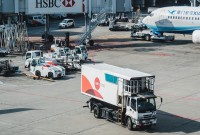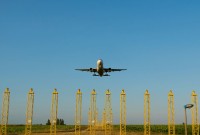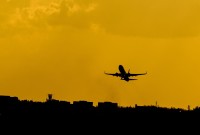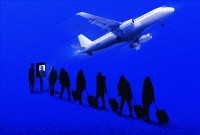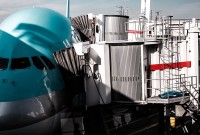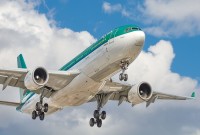- Home
- Business Processes
- Industry Knowledge
- Aerospace Industry
- Automotive Industry
- Banking Domain
- BFSI Industry
- Consumer/ FMCG Industry
- Chemicals Industry
- Engineering & Construction
- Energy Industry
- Education Domain
- Finance Domain
- Hospitality Domain
- Healthcare Industry
- Insurance Domain
- Retail Industry
- Travel and Tourism Domain
- Telecom Industry
- Leadership Skills
- eLearning
- Home
- Domain Knowledge
- Aerospace Industry
- History of Aviation Industry
History of Aviation Industry
An overview of the Aerospace Industry. A brief account of how modern aerospace began way back with Sir George Cayley in 1799 and the success story of the Wright Brothers to today's massive international airspace developments.
Modern aerospace began way back with Sir George Cayley in 1799 when he proposed an aircraft with a fixed-wing and a horizontal and vertical tail, defining characteristics of the modern airplanes. The 19th century saw the creation of the Aeronautical Society of Great Britain, the American Rocketry Society, and the Institute of Aeronautical Sciences, all of which made aeronautics a more serious scientific discipline. Airmen like Otto Lilienthal, who introduced cambered airfoils in 1891, used gliders to analyze aerodynamic forces. The Wright brothers brought about the first powered sustained flight at Kitty Hawk, North Carolina on December 17, 1903. The launch of Sputnik 1 in 1957 started the Space Age, and on July 20th, 1969 Apollo 11 achieved the first manned moon landing. In 1981, the space shuttle "Columbia" launched the start of regular manned access to orbital space. A sustained human presence in orbital space started with "Mir" in 1986 and is continued by the "International Space Station". Space commercialization and space tourism are more recent focuses on aerospace.
Early Years:
Aircraft remained experimental apparatus for five years even after the Wright brother's first flight in December 1903. In 1908 the Wrights secured a contract to make a single aircraft from the U.S. Army, and also licensed their patents to allow the Astra Company to manufacture aircraft in France. Glenn Curtiss of New York began selling his own aircraft in 1909, prompting many American aircraft hobbyists to turn entrepreneurial.
Manufacturing:
Europeans took a clear early lead in aircraft manufacture. By the outbreak of the Great War in August 1914, French firms had built more than 2,000 aircraft; German firms had built about 1,000, and Britain slightly fewer. American firms had built less than a hundred, most of this one of a kind. Seven firms built more than 22,500 of the 400-horsepower Liberty engines, and their efforts laid the foundation for an efficient and well-concentrated aircraft engine industry -- led by Wright Aeronautical Company and Curtiss Aeroplane and Motor.
National Advisory Committee for Aeronautics established was in May 1915 in the United States that spread the scientific information for explicit use to industry. Universities began to offer engineering degrees specific to aircraft. American aircraft designers formed a patent pool in July 1917, whereby all aircraft firms cross-licensed key patents and paid into the pool without fear of infringement suits. The post-war glut of light aircraft allowed anyone who dreamed of flying to become a pilot.
During the 1920s, aircraft assumed their modern shape. By the mid-1930s, metal replaced wood as the material of choice in aircraft construction so new types of component suppliers fed the aircraft manufacturers. Customers of aircraft grew more sophisticated in matching designs to their needs and militaries formed air arms specifically to exploit this new technology. Air transport companies began flying passengers in the 1920s. European nations developed airmail routes around their colonies.
Airmail Business:
The United States was the only country with a large indigenous airmail system, and it drove the structure of the industry during the 1920s. The Kelly Air Mail Act of 1925 gave the airmail business to hundreds of small pilot-owned firms that hopped from airport and airport. Gradually, these operations were consolidated into larger airlines.
Many advances in aircraft design during the 1930s addressed the comfort, efficiency, and safety of air travel - cabin pressurization, retractable landing gear, better instrumentation, and better navigational devices around airports. In the six-year period 1940 through 1945, American firms built 300K military aircraft compared to 20K in the previous six-year period. In 1943, the aviation industry was America's largest producer and employer - with 1345K people working in the aircraft manufacturing sector.
New technologies prompted a massive restructuring of the industry. Established airframe firms shifted from manufacturing to research, while the military channeled funds to technology-specific startup firms. Intercontinental ballistic missile programs started in 1954, fueled the micro-level restructuring of the industry. ICBMs were touted as "winning weapons" to replace massive numbers of aircraft, so missile firms invested in smaller but better factories.
Also revolutionary were the spacecraft and the rockets that lifted them into orbit. The neologism "aerospace" reflected the shape of the money that flowed into the industry following the Soviet launch of Sputnik in October 1957. In 1961, NASA got the mission to send an American to the Moon and return him safely to Earth before the decade was out. NASA built enormous spaceports in Florida and Texas, enhanced its arsenal of research laboratories, bolstered its own network of hardware contractors, opened up new areas of material science, and pioneered new methods of reliability testing. Following the success of Apollo, in the 1970s NASA invested ahead of demand to create the space shuttle for regular access to space. Program management and systems engineering were applied to military aircraft in the 1960s.
International Industry:
International politics has always played a role in aviation. Aircraft in flight easily transcended national borders, so governments jointly developed navigation systems and airspace protocols. Spacecraft overflew national borders within seconds so nations set up international bodies to allocate portions of near-earth space. INTELSAT, an international consortium modeled on COMSAT (the American consortium that governed operations of commercial satellites) standardized the operation of geosynchronous satellites to start the commercialization of space.
International travel grew rapidly, and airlines became some of the world's largest employers. By the late 1950s, the major airlines had transitioned to Boeing or Douglas-built jet airliners -- which carried twice as many passengers at twice the speed in greater comfort. The Boeing 747 took international air travel to a new level after its introduction in January 1970. Each nation had at least one airline, and each airline had slightly different requirements for the aircraft they used. By the 1990s more than thirty nations had some capacity to manufacture complete aircraft. Some made only small, general-purpose aircraft.
Suggested Reading and Resources
Related Links
You May Also Like
-
Civil Aerospace Sector - Sector Profile
In this article, we will discuss the four important sub-sectors of the Civil Aerospace Sector namely “Civil Aircraft Manufacturing”, “Commercial Avionics”, “MRO” and “Commercial Simulation & Training”.
-
Key Sectors of Aerospace and Defense Industry
Understand the categorization of the aerospace industry to various sectors based on the services it currently provides. Understand the key constituents under these sectors and activities under each of these sectors.
-
Civil Aerospace: Maintenance, Repair & Overhaul (MRO)
This subsector under the civil aerospace industry includes the maintenance, repair, and overhaul (Known as MRO) of civil aircraft and aircraft components. This includes line and heavy maintenance of civil aircraft, as well as repair and overhaul of all parts of an aircraft, including engines, electronic components, and avionics, instruments, and aircraft structures.
-
Civil Aviation Sector – A brief History
The civil aviation sector has transformed itself during the last hundred years. There has been massive technological development in passenger traffic and comfort and now the civil aviation industry accounts for approximately 30% of the overall aerospace industry. A brief account of civil aviation history is presented in this article.
-
Civil Aerospace - Commercial Simulation and Training
Training people how to operate and maintain today’s sophisticated aircraft as well as on-board and ground support systems can be very complex and costly. To be effective, the training environment must accurately simulate the features and capabilities of the actual systems in a wide range of operating scenarios. Commercial modeling, visual simulation, flight simulation, and computer-based training are the key methods used by this subsector.
-
Civil Aerospace: Civil Aircraft Manufacturing Industry
This article discusses sectors within the Civil Aerospace Sector and its subsectors, products, and services. This article provides an overview of the definition, industry products, industry activities, and global locations.
-
Aerospace Industry - The Competitive Landscape
This article provides an overview of the competitive landscape of the aerospace industry. Read how the compaction is shaped up across the US and the globe, followed by a detailed discussion of the top 5 players in the sector in terms of revenue.
-
Challenges in the Aerospace and Defense Industry
New market dynamics are dramatically changing the way A&D companies serve their customers, collaborate with partners, and take ideas and solutions to the market. Given below are several vitally important challenges that are currently confronting the aerospace and defense industry and strategies to mitigate them.
-
An overview of the Aerospace Industry. A brief account of how modern aerospace began way back with Sir George Cayley in 1799 and the success story of the Wright Brothers to today's massive international airspace developments.
-
Aerospace Industry: The Business Model
In this article, we will discuss the value chain of the Aerospace Industry and will define the generic business model to understand the key process areas in the aerospace industry. This will provide you with a basic understanding of key activities in the industry.
Explore Our Free Training Articles or
Sign Up to Start With Our eLearning Courses

About Us
Learning
© 2023 TechnoFunc, All Rights Reserved

